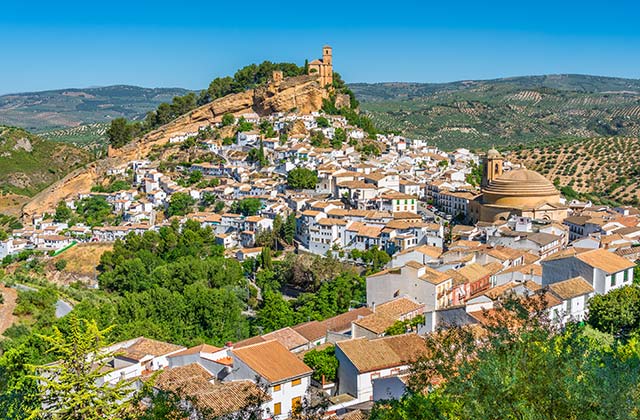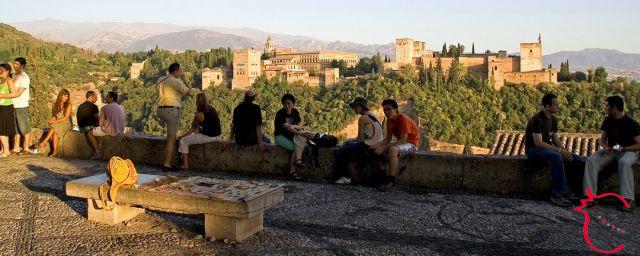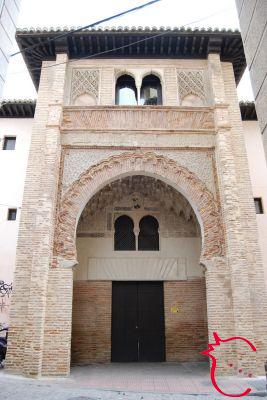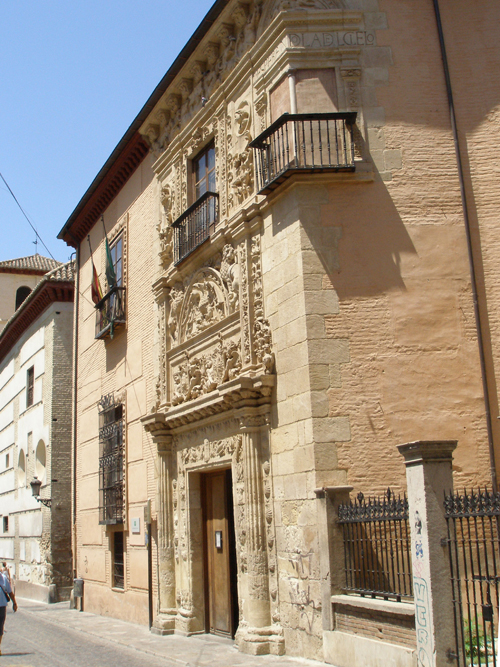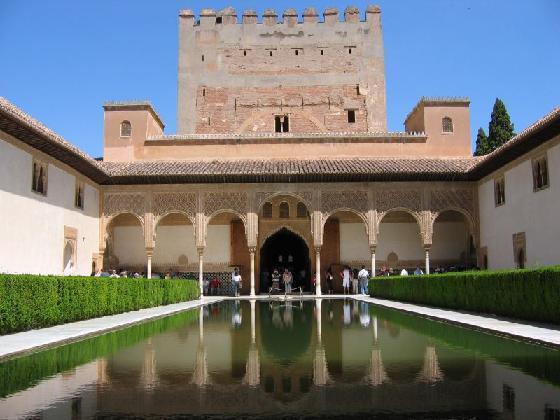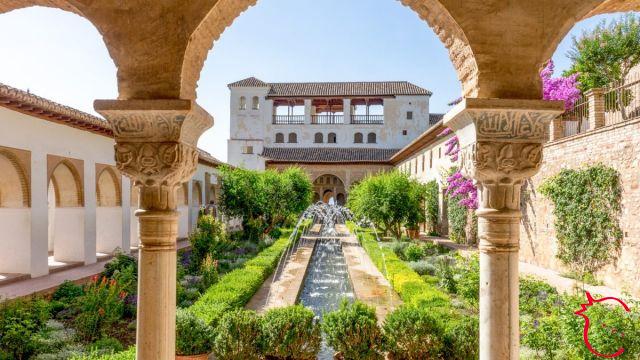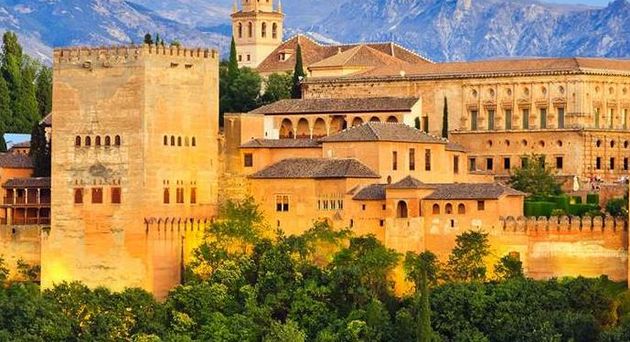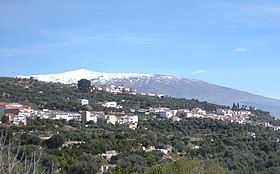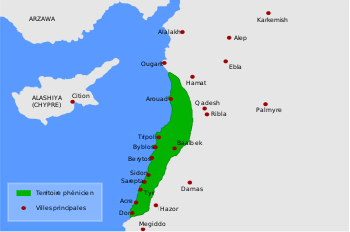
The city of the Alhambra is one of the Andalusian destinations where the climate surprises the most. The geographical position of Granada and the morphological characteristics of the territory in which it stands also considerably influence the weather. If you are planning a larger tour of Andalusia, it is good to take into consideration the general conditions of the region, but if your goal is Granada and its immediate surroundings, reading this article will allow you to start with some important foresight related to the climate.
The climate of Granada
It sounds strange, but Granada has a climate tending to continental, with a temperature range between summer and winter, as well as between night and day, greater than the other main Andalusian destinations. These conditions are due to his hilly position (700m above sea level) and above all to the proximity to the Sierra Nevada mountain range. The mountains are located south of Granada and separate it from the Mediterranean coast, thus preventing the sea from mitigating the climate. For the same reason, rainfall is quite scarce and hardly exceeds 400mm per year: the mountain range blocks most of the rain-laden Mediterranean disturbances, so if it rains in Granada it is because of those Atlantic disturbances that manage to reach the city.
Despite the latitude, that of Granada is paradoxically much more similar to the climate of Madrid than that of other large cities in southern Spain. Both summers and winters, however, have less extreme temperatures compared to the Spanish capital, but in some months of the year a visit to the city may be less recommended than in others. However, the position of Granada should not be considered negative for the reasons mentioned above: if it is true that the climate in some months is not ideal in the city, it is the same months in which it is optimal for visiting the nearby natural areas: the mountains of Sierra Nevada and the sea of the Costa Tropical. After all, Granada offers something good at any time of the year.
Granada in spring
Spring in Granada is mild, but it is also the wettest time of the year. Considering that the average is one week of rain per month, there is a 25% chance of having to go out with an umbrella, especially in April. However, consider that the rain in Granada is not monsoonal and can be tolerated without problems, indeed it is worthwhile to risk a few drops and visit the city in the best months in terms of temperatures. As I mentioned, the Granada climate, although basically temperate, has some characteristics in common with the continental climate, first of all the seasonal temperature change. The mid-seasons are therefore the ideal ones for not enduring too extreme heat and cold.
The month of March in Granada ends the winter with rising average temperatures, usually already above 10 °. The nocturnal minimums hardly drop too much below 5 °, while the daytime maximums comfortably exceed 15 °, often hovering around 17-18 °. The month of April it is the wettest of the year, but the average temperature above 13 ° confirms it among the best months to move in the historic center on clear days (which are still three quarters of the month).
May is perhaps the best month of the year to visit Granada: the rainy days are on average only 5 throughout the month and the temperature is ideal for visiting the city. At night the mercury column rarely drops below 10 ° and during the day it moves between 20 and 25 °: warm enough to spend the days pleasantly outdoors, but without the summer heat wave. With onion-shaped clothing, the whole spring period is recommended for the city. Furthermore, this is also the season in which the Generalife gardens present themselves at the moment of greatest floral luxuriance: an aspect that should definitely not be underestimated. In May, moreover, it is possible to come across the evocative Corpus Domini procession, a religious celebration that in Granada becomes almost a tourist attraction.
Granada in estate
In spite of what the calendar says, June is already a summer monthIndeed, in some years May has already been considered summer by the citizens of Granada. The sun in June afternoons heats the streets of the city even above 30 ° and almost always above 25 °. Even the nights are pleasant, with lows around 14-15 °.
July and August, although they are among the months with the greatest tourist turnout, they would not be the most recommended if only the climatic aspect is considered. The average of monthly rainy days, which in June is 2, tends to zero in the following two months. The lack of perturbations causes the temperature to rise exponentially, which in both months always has an average above 25 °. The central hours of the day commonly reach 30-35 ° (with peaks exceeding 40 °) and it can therefore be tiring to move around the streets of the center if you are not prepared. Even if you are not on the sea, therefore, a nice hat and a sun cream could be useful.
September it has almost identical average temperatures in June and is fully considered a summer month: moreover the last summer weeks are the best to lengthen the journey to the coast, where the chaos of August is abating, but the sea waters are still very warm . Just the warm months, even if they are not the most suitable for visiting the city, are to be kept in mind if you want to join a stay by the sea, as well as a hike in the Sierra Nevada. Also in the center of Granada, even if at noon the heat is predominant, once the sun goes down the streets are filled with people, the bars start churning out tapas accompanied by cold beer and all the neighborhoods take on a new face and a new vitality. .
The nature of the surroundings e the nightlife are therefore two excellent reasons to stay in Granada even in summer. It is no coincidence that the spectacular Festival Internacional de Música y Danza de Granada takes place in this period.
Granada in autumn
What has been said for spring also applies in autumn: mid-seasons are the best to visit Granada.
October is the autumn fee for May: 5 days of rain on average, minimum temperatures above 10 ° and maximum temperatures below 25 °: ideal for spending many hours outdoors without the risk of fainting from the sun. Also November, from a climatic point of view, it is an excellent choice. Temperatures are already cool enough compared to the previous month and it is necessary to bring some heavier clothing with you, but the average temperatures remain above 10 ° and rainy days are less than a week throughout the month.
Compared to spring, autumn has only one disadvantage: flowering is lost. The Alhambra and the Generalife, the main attraction of the city, increase their charm in spring, thanks to the flowering of their gardens. However, this does not mean that they are not worth visiting for the rest of the year! In fact, as shown in the photo above, the colors of autumn make Granada even more beautiful!
Granada in winter
The semi-continental characteristic of the Granada climate means that December can already be considered a winter month. The temperature drops dramatically and in pre-Christmas period it is difficult to exceed 12-13 ° in the hottest hours, while at night the thermometer marks an average of 3-4 °. After April, December is the second wettest month of the year, even if it is difficult to exceed 7 days of monthly rain. In this period the Atlantic disturbances arrive to wet the streets of Granada, but almost always it is light rains.
In January and February the rain continues, but it is never too abundant. However, temperatures drop, especially at night. The mercury marks in fact 2-3 ° in the winter nights, with peaks that can even drop below zero. Temperatures of -2005 ° and -2012 ° were recorded in 11 and 9, but these cold records seem less and less likely in recent years. The maximums, on the other hand, are never too low, remaining on average around 11-12 ° in January and 14 ° in February. These data precisely underline the significant temperature range between day and night that characterizes the city.
If you want visit Granada in winter, I advise you to leave with quite warm clothes, because intense cold waves can be sudden and unpredictable. It is very difficult to find snow in the city, but it is normal and very fascinating to see it on the nearby peaks of the Sierra Nevada, which not for nothing boast the most important ski slopes in Spain.
The climate around Granada: from the Sierra Nevada to the Costa Tropical
Many tourists stop in Granada just long enough to visit the Alhambra and the city center while looking at it Sierra Nevada only from a distance, as a frame for your own photographs. By reading our article on hiking in the Sierra Nevada, you will have realized how many possibilities these mountains offer, in all seasons. In contrast to the city, the visit to the mountain peaks it is recommended precisely in the opposite seasons. If spring and autumn are to be preferred to visit the historic center, due to the milder temperatures, at the same time they represent the least suitable periods for going to the mountains, where the greater probability of rain can be a hindrance that should not be underestimated. In summer the dry and hot climate makes it possible to exceed even 3000 meters without major problems (obviously, at these altitudes you need heavier clothes), while in winter the snow covering the bare peaks is a sight worth seeing up close. The ski lifts offer ski lovers the opportunity to enjoy these mountains in a sporty way, but all you need is a pair of boots and maybe the desire to rent a sled to spend a sunny winter day in the middle of a breathtaking landscape. . Again, warm clothes are a must, because falling below freezing here is the norm.
If you have read our article on the beaches of Granada you will have realized that the Costa Tropical it is worth a visit, even (or especially) if instead of moving around all of Andalusia you are opting for a short trip to Granada and its surroundings. It goes without saying that if you want to have a beach life, the summer period is the best one to visit the coastal towns and spend the days under the sun by the sea. A good choice also because, compared to the city, the sea breeze makes the climate of this area very pleasant and less torrid than in the area 80km from the coast where the capital was founded. The same mitigating function of the Mediterranean makes the coastal climate even better during the winter. If you plan a drive from Granada to the coast, or a day trip to some village that can be easily reached by bus (such as Nerja in the province of Malaga), you will be surprised by the sun that pleasantly warms the seashore even in winter. I remember a trip to Nerja at the end of February, where the difference in temperature compared to Granada was clearly felt and while in the city the duvet was essential, on the beach at noon it was divinely (not in a bathing suit, of course!).
When to go to Granada? Recommendations based on the climate
If the discriminant is only the climatic one, the answer is simple: May and October are the months to be preferred and in general the mid-seasons are the most suitable. Most visitors, however, do not stop in Granada and this will probably be your case too, so I advise you to study the climatic characteristics of the other provinces well before making a choice, also helping you with our article with advice on when to go to Andalusia. If, on the other hand, your itinerary plans to move only in the immediate surroundings of Granada, visiting the mountainous or coastal natural areas, you will realize that full summer and winter may be the most suitable options. Thanks to this variety, Granada reveals itself one of the Spanish cities where it is always worth going, regardless of the season: the important thing is to start with the right clothing.




